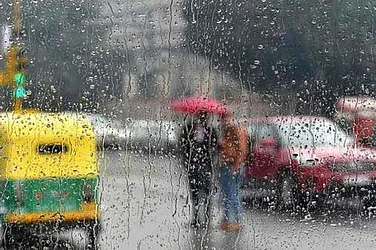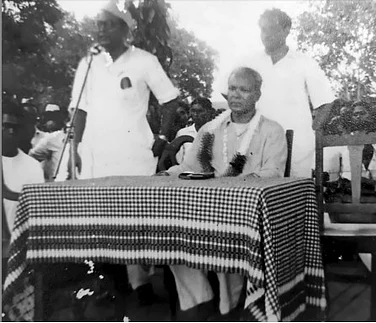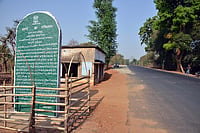Mohammad Jalil is 35 years of age but he can very well remember the ever-changing seasons of Ranchi over the last 50 years. He says that his father, Rozamat Ansari, who is 71-years-old, can explain how the weather of Ranchi used to be many years ago. However, Jalil, a resident of Kadru Sarna Toli, says, “About 10 years ago, the pond in Kadru locality had water in it. Five years prior to that, the people of the locality used the water for bathing and cleaning purposes. From Gwala Toli, an area near Hindpiri, thousands of buffaloes were brought daily for bathing in this locality.
The pond had so much water in it that a tall person could have easily drowned in it. People did not have ‘boring’ done in their houses. There were wells and ponds in the area. Now the pond has dried up completely. Rains do not pour as heavily as they did earlier. The ‘boring’ done in houses is of no use.”
Jalil is forced to cover a distance of 2 kms to fetch water. The main reason for the ponds to dry up is the construction of high-rise buildings in the area. The multi-storeyed Haj house was built very near to the Kadru pond in 2019 due to which the catchment area (an area from which surface run-off is carried away by a single drainage system) of the pond has got closed. As a result, the pond has turned into a playing ground.
Jalil informs that there used to be a similar kind of a pond at Barik Tola. Located at a distance of 1.5 km from Kadru, the pond used to be filled with water. Today, an apartment has been constructed on the same pond and many buildings have come up along the sides.
Twenty-three years ago, the states of Chattisgarh, Uttarakhand, and Jharkhand came into existence after a movement of prolonged struggle. Ranchi was made the capital of Jharkhand. Once famous as a hill station, Ranchi has now become an urban heat island in recent years. Experts believe that the changing weather of Ranchi is due to climate change. Last year’s summer temperatures broke the record of the last 45 years.
According to the weather department, from 1969 to 2014, the maximum temperature of Ranchi on an average remained 35.8 degrees, and between 2015 and 2021, it remained around 36.7 degrees. There used to heavy rains during this time. However, this has been the first time in the last 23 years that it did not rain in the month of April. On an average, it used to rain for five to seven days in the month of April. This year the maximum temperature of Ranchi remained above 40 degrees. Ponds were used to predict the trend of rainfall in Ranchi during the summer months. But now the ponds are slowly drying up.
Nitish Priyadarshi, environmentalist and professor at Ranchi University, says, “We need to understand the hydrologic cycle of Ranchi. Ranchi was known as the city of ponds. There were more than 300 ponds, small and big, in the district that continued to exist even after Independence. Now, the number has reduced to 55 to 60. Ponds helped in maintaining the temperature of Ranchi. When there was extreme heat, the air from these ponds used to act as a cooler for the city. Secondly, due to increased heat, there was evaporation that brought a good amount of rainfall here. That was local rainfall. Thirdly, water accumulated in ditches and ponds helped recharge the sub-surface water levels of wells and ground water. However, the innumerable buildings being constructed have made Ranchi the city of concrete. As a result, 50 to 60 per cent of rainwater gets drained away. There is not much rainfall as the ponds have disappeared. Due to urbanisation, too, rain water does not collect in the ponds. Summers are becoming unbearable in Ranchi the way it is in many cities across the country.”
Priyadarshi also explains that before 1970, people did not use fans much. In the years that followed, all of a sudden, people started using fans. Fifteen-twenty years ago, there used to be a good amount of rainfall if the temperature rose to 35 or 40 degrees. In the recent years, there has been a drastic change in the weather leading to an imbalance.
As per one of the reports, there were around 10,000 ponds in Jharkhand and around 600 in Ranchi. Sanjeev Vijayvargiya, the deputy mayor of the Ranchi Municipal Corporation, informs that there are only 42 ponds in the city today and many of these have dried up. He says that whatever ponds are left have been badly affected as the catchment areas have been closed due to massive construction. As a result, water overflows in the entire city instead of draining into the ponds.
Vijayvargiya adds, “When the municipal corporation came forward and tried to save these ponds, it was too late. The main problem is that the speed at which the construction work is going on in the city is much more than that of the corporation efforts in restoring the ponds. There are many ponds in the city where land mafias have constructed flats. The onus of preservation of the city and the environment lies more on us than the government.”
Along with the formation of Jharkhand state, Uttarakhand state was also formed. Its capital city, Dehradun, is known for its pleasant environment and the hill station is known as the city of canals. Due to these canals, the weather of Dehradun used to be as cold as that of Europe. Now, the summers here have become as hot as those of Central India.
Explaining the reason for the change, senior journalist Manmeet Rawat says that the canals are still around but most have been flowing underground now. Rawat, who has been working on environmental issues for many years, says, “Dehradun has suffered a lot due to the canals going underground. There used to three big canals which were joined by 50 to 60 smaller canals and these used to flow together. The canals helped in maintaining the temperature of the place. The temperature used to be around 30 degrees if there was extreme heat in summers. However, things changed in the year 2000, when Dehradun was made the capital city and urbanisation increased manifold. The canals were made to flow underground. Roads were constructed over these canals, leading to an increase in temperature. Different species of birds were left dehydrated and they had to eventually migrate to different areas.”
Rawat adds, “Northern India has three kinds of rainfall. The first one is due to a western disturbance. In this phenomenon, clouds are formed due to the presence of the Mediterranean Sea and on account of these hitting the Himalayas, there is rainfall. Secondly, due to the eastern disturbance, clouds from the Bay of Bengal bring rains. The third one is due to a local disturbance which is of utmost importance. As the temperature increases, evaporation takes place and big clouds form. There are two things required for evaporation. First is a rise in temperature and second is the presence of a reservoir below. Now, the temperature is increasing but there is no way through which evaporation can take place. Local disturbance played a significant role when there were open canals, thereby maintaining the water cycle and the temperature of the city. After 2007, all the canals of the city have gone underground. At present, the temperature of the city goes up to 40, even 45 degrees.”
S P Sati, professor of environment, Bharsar University, is of the opinion that the canals have not only been sent underground but have been demolished too. He says, “Due to urbanization, around 10 to 15 lakhs of fruit bearing trees have been felled. Thirty-forty per cent of agricultural lands have been converted to residential land. There are no agricultural lands left and the canals have been closed. Concrete roads have been made. Water does not stop and it drains away. Water from these canals used to go the agricultural lands as these were very broad. Water from the agricultural fields used to enter the land and got collected at the surface too. This led to evaporation and thereby rainfall.”
With the ponds of Ranchi and the canals of Dehradun disappearing, it is becoming clear that summers will only get more brutal with the continued loss of crucial water reservoirs. It is, therefore, of utmost importance that civic bodies take up the cause of maintaining existing reservoirs and preventing them from being lost to the burgeoning infrastructure sector in both the ecologically sensitive cities.
(Translated by Kaveri Mishra)



























